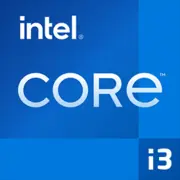Intel Core i3-1220P

Intel Core i3-1220P: 2025年の日常タスク向けユニバーサルプロセッサ
2025年3月
アーキテクチャとプロセス: Alder Lakeのハイブリッドパワー
2022年に発売されたIntel Core i3-1220Pプロセッサは、革命的なAlder Lake世代の一部です。そのハイブリッドアーキテクチャは、2つの高性能コア(Pコア)と8つのエネルギー効率の良いコア(Eコア)を組み合わせており、合計で10コア12スレッド(Pコアはハイパースレッディングをサポート)を提供します。Intel 7プロセス(以前は10nm Enhanced SuperFinとして知られていた)は、パワーとエネルギー効率のバランスを実現します。
- クロック周波数: Pコアのベースクロックは1.5GHzで、ターボモード時の最大周波数は4.4GHzです。Eコアは1.1〜3.3 GHzで動作します。
- キャッシュ: 12MBのL3キャッシュは、マルチタスクシナリオでデータ処理を加速します。
- 統合グラフィックス: 第12世代のIntel UHD Graphicsは、64の実行ユニット(EU)を搭載。4K/60Hz、HDMI 2.1、およびAV1デコーディングをサポートしています。
ハイブリッドアーキテクチャは自動的にタスクを配分します:Pコアは重いアプリケーション(例えば、Photoshop)を処理し、Eコアはバックグラウンドプロセス(更新、ストリーミング)を処理します。これにより、システムの応答性を損なうことなく、エネルギー消費を抑えています。
エネルギー消費とTDP: パワーとバッテリー持続力のバランス
プロセッサの公称TDPは28Wですが、実際にはターボモード時には35〜40Wまで消費する可能性があります。これにより、薄型ウルトラブックやアクティブ冷却デバイスに適しています。
- 熱設計: i3-1220Pを搭載したノートパソコンは、コンパクトなクーラーを装備していることが多く、負荷に対応できますが、ターボ時には長時間の作業で騒音が発生する場合があります。
- エネルギー効率: 第11世代(Tiger Lake)と比較して、Alder LakeはEタイプのコアの最適化によりエネルギー消費を10〜15%削減しました。
パフォーマンス: 実際のタスクとターボモード
Geekbench 6(シングルスレッド1961 / マルチスレッド6895)は、エントリーレベルのプロセッサとしては良好な指標です。
- オフィス作業: Chromeで20以上のタブ、Microsoft Office、Zoom会議を容易に処理します。
- マルチメディア: Lightroomでの写真編集は遅延なく行え、Premiere Proでの1080p動画のレンダリングには2〜3分かかります(Ryzen 5 7530Uでは1.5分)。
- ゲーム: 統合グラフィックスは、低設定でCS2を60〜70FPSで動かせますが、Forza Horizon 5は20〜25FPSで動作します。
ターボブースト: 短期間の負荷(例えば、大きなExcelファイルを開く時)では、Pコアのクロック周波数が4.4GHzに跳ね上がります。しかし、20〜30秒後には、コンパクトなケースでの過熱によりスロットリングが発生する可能性があります。
使用シナリオ: i3-1220Pは誰に向いているか?
- 学生: テキスト作成、オンラインコース、プレゼンテーションの軽い編集。
- オフィスワーカー: メール、スプレッドシート、ブラウザ間のマルチタスク。
- 移動中のユーザー: Netflix視聴、ソーシャルメディア、クラウドサービス。
向かない:
- Ultra設定を必要とするゲーマー。
- 3Dレンダリングや4K編集のプロフェッショナル。
バッテリー持続力: ノートパソコンはどれくらい持つか?
バッテリー容量が50〜60Wh(2025年のウルトラブックで一般的)である場合:
- ウェブサーフィン: 6〜8時間。
- 動画(1080p): 9〜10時間(AV1によるハードウェアデコーディングのおかげ)。
- 負荷(Photoshop + ブラウザ): 3〜4時間。
省エネルギー技術:
- Intel Dynamic Tuning 2.0: 負荷に応じてTDPを適応的に調整。
- Speed Shift: モード切替時の遅延を減少。
競合他社との比較: AMD、Apple、および過去の世代
- AMD Ryzen 5 7530U (Zen 3): 6コア / 12スレッド、TDP 15〜25W。マルチスレッドタスクで優れている(Geekbench Multi ~7200)が、シングルスレッドでは劣ります(~1850)。
- Apple M1: 8コア(4+4)、Geekbench Multi ~7500。バッテリー持続力(最大15時間)とグラフィック性能では優位ですが、macOSに制限され、ソフトウェアの互換性に課題があります。
- Intel Core i5-1135G7 (第11世代): マルチスレッド性能でi3-1220Pより20〜25%劣ります。
長所と短所
強み:
- オフィス作業向けの高いシングルスレッド性能。
- DDR5-4800およびPCIe 4.0(高速SSD)をサポート。
- 4Kモニターや周辺機器を接続するためのThunderbolt 4。
弱み:
- AMD Radeon 660Mよりも弱いグラフィックス。
- i5/i7 Alder Lakeに比べてEコアが少ない。
- 薄型ケースでの熱。
ノートパソコン選びのアドバイス
- デバイスタイプ: ウルトラブック(例: Lenovo Yoga Slim 7i)、予算向けノートパソコン(HP 255 G9)。
- 注目するポイント:
- 冷却: 2つのファンが1つよりも優れています。
- RAM: 最低16GB DDR5。
- ディスプレイ: 300nitの明るさを持つIPSパネル。
- 価格: 2025年の新モデルは700〜900ドル。
HDDや8GB RAMのデバイスは避けましょう—これはパフォーマンスの「ボトルネック」です。
総括
Intel Core i3-1220Pは2025年において、価格と性能のバランスを求める人にとって、依然として優れた選択肢です。以下のような方に最適です:
- 日常的なタスク(オフィス、学習、エンターテイメント)。
- ポータビリティとThunderbolt 4を重視するユーザー。
- i5やRyzen 5の「余分な」コアに過剰に支払うつもりがない方。
700〜900ドルで信頼できるバッテリー持続力と基本的なタスクに十分なパワーを求めているなら、i3-1220Pがあなたの選択肢です。ゲームやプロフェッショナルな作業には、ディスクリートGPUやCore i5/Ryzen 7クラスのモデルを検討してください。
基本
CPUの仕様
メモリ仕様
GPUの仕様
その他
ベンチマーク
他のCPUとの比較
ソーシャルメディアで共有する
または当サイトへのリンクを追加
<a href="https://cputronic.com/ja/cpu/intel-core-i3-1220p" target="_blank">Intel Core i3-1220P</a>